In the early 1930's Fiat had a dual advantage over their rivals, having a virtual monopoly of the Italian family-car market; but equally as makers of 90 per cent of Italy's private cars they could not afford a bad mistake. Nor was Italy the healthiest of home markets: in 1929, only 172,000 cars overall had been in use, and a high rate of production depended upon substantial exports.
Their previous light car, the 1·4-liter Tipo 514, had been somewhat of a lemon; uninspired in appearance and performance alike, it was too big and thirsty for the lean (depression) years, while an attempt to save the day with an 'austerity' version, Tipo 515, had been rewarded by derisory sales. The 995 c.c. Balilla was to prove a worthier successor to the 509 of similar capacity made between 1925 and 1929.
Automotive historians of today will tell you the period phrase 'Family Ten' conjures up visions of side-valve engines with two-bearing crankshafts of dubious strength, mated to wide-ratio three-speed gearboxes. In the chassis department you would expect conventional semi-elliptic springs, and cable-operated brakes that were unpredictable in a forward direction, and only too predictable in reverse. The influence of Detroit was reflected in ribbon-type radiator shells, wire wheels painted to match the body colour, and instruments arranged in the interests of symmetry rather than legibility.
The fashionable chromium-plated hub caps were best removed with the aid of a blunt kitchen knife. On the credit side, it should be remembered that many of these soulless vehicles had their lives forcibly prolonged by the second World War, during which they rendered yeoman service despite a lack of spares and service alike.
The Ballila
On looks alone, Fiat's 1932 offering differed little from its competitors, having inherited its Chrysler styling from the Tipo 514 and the companion 2-liter Tipo 522; but its specification was advanced by comparison with other small saloons of the period, such as the 201C Peugeot from France, the 1.2-liter Opel from Germany, and such British contributions as Hillman's Minx, Standard's Little Nine, and Austin's Ten, all new for 1932, and all fighting hard for sales in a constricted market.
Side valves were almost universal in this stratum of automobile design, and Fiat were not alone in adopting a three-bearing crankshaft, also used by Hillman, Austin, and Opel. Where they differed was in their espousal of nearly 'square' engine dimensions of 65 x 75 mm., all their rivals opting for piston strokes in excess of 85 mm. As yet this configuration's value in lowering piston speeds and thus prolonging engine life was not fully understood and Fiat's advertising made much of the point.
Maximum power (a modest 22 b.h.p.) was developed at 3,400 r.p.m., and the little 508 had an excellent reputation for durability. Synchromesh on small cars was virtually unknown in 1932, and three forward speeds were as yet deemed adequate, only Austin offering a four-speed gearbox. However, the Balilla's 5·2:1 top gear was respectably high by the standards of the times, and this allied with the short-stroke power unit enabled the little car to hold 50-55 m.p.h. all day. The Peugeot, by contrast, had a top gear ratio of 6·25 :1, in which respect it was by no means unique!
The gravity feed from dash-mounted tank to Zenith carburetor was a trifle archaic - all the competing cars save the Peugeot had their tanks at the rear, and Hillman, Austin, and Opel made use of mechanical pumps-but it had the merit of simplicity and was to be retained by Fiat on their famous 'Topolino' until the late 1940s. 6-volt eIectrics were deemed sufficient for all save Fiat and Peugeot, and Fiat's pedal-operated starter, which first set the pinion in mesh with a toothed ring on the flywheel, and then switched on the current, was quiet in operation. The ignition distributor was 3 Trasformazione mounted on top of the engine, a location which made it flood-proof.
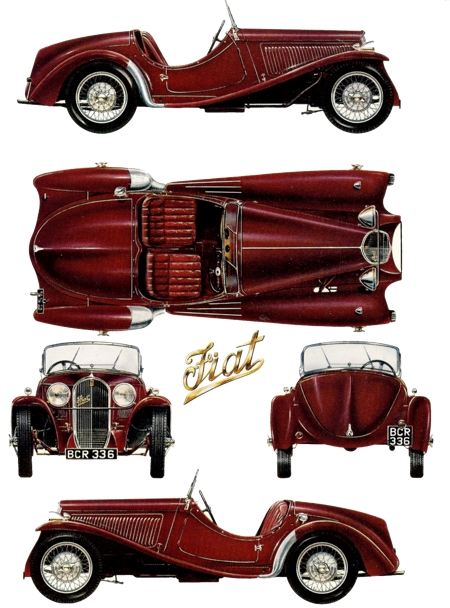 The 1935 Fiat Tipo 5085 Balilla Sports two seater...
The 1935 Fiat Tipo 5085 Balilla Sports two seater... |
As for the chassis, Fiat were well ahead of all their rivals. True, they did not as yet, like Peugeot, aspire to independently-sprung front wheels, but their new car was equipped with hydraulic brakes of proven efficiency. The company had been using them since the end of 1930, when they were first applied to the 3·7-liter Tipo 525. These were supplemented by the traditional Fiat transmission handbrake, a device retained until the 1960s. It was strictly a sudden-death affair, and reserved for parking. By contrast, the other cars mentioned previously had mechanical brakes, Standard and Hillman favouring the Bendix type.
With a wheelbase of 7 ft. 4½ in., the Balilla was 1½ in. shorter than any of its rivals, while the taxi-like steering lock was reflected in a turning circle of 29 ft. 6in. In other respects the chassis was conventional, with spiral bevel final drive. The fabric couplings on the propeller shaft had a relatively short life, but were quick and inexpensive to replace. A stop light was standard equipment, and Fiat's came equipped with a hand throttle (a legacy that would remain for the next 3 decades). A free wheel mounted behind the gearbox was an optional extra, control being by a knob on the dashboard.
Maximum speed of early 508s as tested was 58 m.p.h., with fuel consumption at 35 m.p.g. repr esenting a great improvement on the cumbersome 514. In less lean times it was possible that the FIAT at £198 might have been serious competition even in Englan, given the list price of a Standard in 1932 was £155, and the Hillman was £159. However the UK the government had introduced a horse-power tax which favored the long-stroke engine, and British buyers expected more car than Turin offered in an 'Eleven'. The name 'Balilla', incidentally, is best translated as 'plucky little one', and was derived from a Fascist youth movement corresponding roughly to the Boy Scouts. The correct designation of the 995 c.c. engine was 'Tipo 108', this being in accordance with Fiat's inter-War practice of assigning prefixes in the 500 series to chassis, and in the '100' series to power units.
The 508S Spyder Sport
Production did not get under way until July 1932, but immediate success was reflected in the sale of 12,424 units in the first half-year. Four body styles were standardised - the basic two-door saloon, a roadster with dickey seat, a four-door open tourer, and a light delivery van. In January, 1933, the higher of the two available compression ratios (6·3:1) was standardised, while at the same time the range was augmented by the introduction of a 'Spyder Sport' model designated Tipo 508S.
Chassis changes were relatively few: output was boosted to 30 b.h.p., the axle ratio was raised substantially to 4·3:1 in the interests of fast cruising, and fuel was fed by mechanical pump from a twelve-gallon tank at the rear. Friction-type shock absorbers replaced the 508's hydraulics. The bodywork, however, represented a complete breakaway from the American idiom, and owed a good deal to the Zagato-bodied Alfa Romeos of the period. Rakish lines were accentuated by long flared wings, and the circular dials on the fascia were laid out in a line, Alfa-fashion. A handsome raked radiator grille was doubtless inspired by some of the trasformazioni effected on this chassis by Italian specialist coachbuilders.
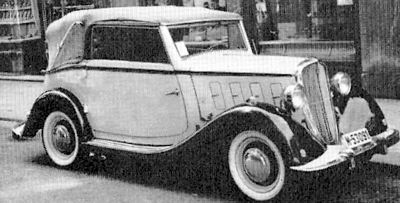 This picture is of a semi-custom style four seater cabriolet by Garavini, which featured a 4 speed gearbox and front bumper...
This picture is of a semi-custom style four seater cabriolet by Garavini, which featured a 4 speed gearbox and front bumper... |
The high gearing gave these side-valve sporting versions a top speed in the region of 70 m.p.h. A standard Balilla took eighth place in general classification in the 1933 Monte Carlo Rally, and that year's Mille Miglia was to see the
debut of two of the outstanding sports cars of the 1930s. One of these was of course, M.G.'s K3 Magnette. Its principal opposition in the 1,100 c.c. class came from Maserati but also in the list were four sports Balillas. Not that these were exactly representative of the Spyder Sport as sold by the factory: Count 'Johnny' Lurani, who was driving for M.G. during the 1933 Mille Miglia described them as 'very non-standard indeed'. They had o.h.v. heads by SIATA, who also furnished the four-speed gearboxes. Even with this 'tweaking' however, output was still a modest 35-40 b.h.p., while the M.G.'s had 100 plus, and they were running unblown.
No surprise then that M.G. won their class deservedly, Eyston and Lurani on the leading car putting up an average of 56·89 m.p.h. The fastest Fiat, driven by Ambrosini and Menchetti, turned in 54·67 m.p.h. over the thousand miles. The difference in speed would doubtless have been greater had the cars from Abingdon not been dogged by plug trouble, but the lesson was there to see. The catalogue price of a K3 was over £600, while the cost of a Balilla complete with all modifications (if it were possible to have been sold in the UK) would have been around £350.
In the touring category, Fiat's record was even more impressive, for these entries really were standard - apart from raised compressions and higher gearing - yet the class-winner averaged nearly 54 m.p.h. and was followed home by twelve similar machines at intervals of four minutes. Otherwise the 508's competition record in 1933 was un-spectacular. Prince Narischkine fielded a team of three cars in the International Alpine Trial, but these were trounced by the M.G. and Singer opposition, while in the 1,100 c.c. class of the Coppa Acerbo Cecchini on the fastest of the Balillas had to trail behind Whitney Straight's K3 Magnette and three Maseratis. The 508's day was yet to come.
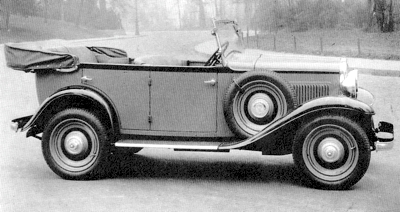 American influences are clearly visible in this 1933 three-speed 508 Torpedo, with its slightly raked windscreen, belt moulding and side-mounted spare...
American influences are clearly visible in this 1933 three-speed 508 Torpedo, with its slightly raked windscreen, belt moulding and side-mounted spare... |
The 1933-34 Models
At the 1933 London Motor Show, the company exhibited a four-door pillarless saloon on the standard side valve chassis. This type of body, used by FIAT unti 1952, offered easy access to all four seats. The short- stroke principle was also extended to a brace of big fours (Tipo 518) powered by 1·7-liter (78 x 92 mm.) and 2-liter (82 x 92 mm.) engines.
As yet the three- speed gearbox was still fitted to the Balilla, but by the time deliveries of the new saloon model were under way, the side-valve design had been finalised into a form that would prevail until the end of production in 1937. At the Milan Show in 1934, a four-door saloon with four forward speeds had been displayed, and by June production was concentrated on the new type. This featured a sloping grille similar to the 518's, while a four-speed box, with synchromesh on the top two ratios, was now standardised. Top and third were fairly close, at 5·1 and 7·5 to 1, but there was the usual long gap between third and second.
The wheelbase was lengthened by two inches, and the tourers as well as the saloons had integral luggage boots. Weight of the saloon went up to 15 cwt., but with a 6·6:1 compression ratio 24 b.h.p. was now available, and road test figures show no appreciable difference in performance. Wire wheels remained an option, and a single central dial was now used for the instruments. English prices were drastically reduced, the saloon costing £210 in 1935 as against £270 in 1934, but the high horsepower tax and pre- vailing antipathy to all things Italian conspired to keep the Balilla a rarity on this side of the ChanneL Elsewhere, however, sales were booming.
The peak year was 1934, with 27,774 cars delivered, but this figure was nearly equalled in 1935 despite Italian preoccupation with the war in Abyssinia, and overall sales of all types between 1932 and 1937 exceeded 113,000. Cars were also built under licence in Germany by N.S.U. and in France by Simca. Apart from minor differences of styling, these French and German FIATs were identical to the Torinese article. Body styles listed in the last three seasons of manufacture were two- and four-door saloons, both with integral trunks, a tourer, a roadster, and a delivery van, though some pretty four-seater cabriolets were turned out on a semi-series basis by Garavini.
After the advent of the o.h.v. 508S in 1934, the basic Balilla took a back seat in competition, but in 1935 C. E. Stothert won his class in the Welsh Rally, and a far more important success was Kozma's eleventh place in the 1936 Monte Carlo Rally. He also won the light-car class and took second place in the appropriate section of the Concours de Confort. (One wonders what he' did to the FIAT's usually rather austere interior appointments!).
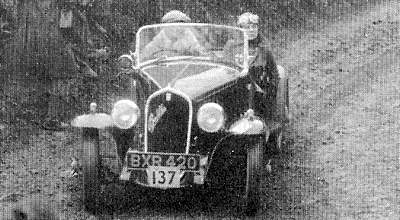 Despite their high gearing, the Balillas did well in trials...
Despite their high gearing, the Balillas did well in trials... |
The O.H.V. 508S
Meanwhile yet another 508 variant had shared the honours of the 1934 Milan Show with the four-speed Balilla saloon-the wholly delightful o.h.v. 508S. This was one of these limited-production cars that FIAT brings out from time to time. The 'full' sports Balilla followed logically on the efforts of the amateur tuners and of firms like SIATA. By the end of 1933 Ambrosini had achieved considerable success in sprints and hill-climbs with a single-seater based on the Spyder Sport, but with o.h.v. head, a chain- driven Roots-type blower, and Cozette carburetor.
On a 4:1 axle ratio this had clocked 96 m.p.h. - not surprising when you consider that the little unit was now delivering 48 b.h.p, at 4,000 r.p.m., and the whole outfit weighed 10 cwt. as against 13½ cwt. for the contemporary two-door saloon, and 12½ cwt. for the sports model in road trim.
Fiat's own sports version was externally identical to the 1933 Spyder Sport, and there were no chassis changes. Nor, for all their pioneering work in Grand Prix racing, did they have recourse to a supercharger. The 1934 synchromesh box was used, with respect- ably close ratios, and the higher overall gearing of its s.v. predecessors. This 4·3:1 ratio made for higher cruising speeds than were comfortably attained with the FIAT's English counterparts-the Le Mans Singer and the PB-type M.G.-which had top gears of 5'57 and 5·75 to 1 respectively, and developed their maximum power at over 5,000 r.p.m., a state of affairs which was hard on the Singer's two-bearing crankshaft.
The Autocarcommented with pleased surprise on the fact that on the 508S 60 m.p.h. in third was the equivalent of a mere 4,500 r.p.m.-neither M.G. nor Singer could attain this speed on this ratio.
A manual ignition control was provided on the sports Fiat's. Cylinder capacity was unchanged at 995 c.c. which suggests that the car was regarded as a development model rather than a serious contender in the 1,100 c.c. category, but an entirely new cast-iron head with pushrod operated o.h.v. was provided, boosting output to 36 b.h.p. on a 7·1:1 compression ratio sufficient to propel the 508S at over 70 m.p.h. This: incidentally, was the first use of pushrods on a touring FIAT engine since the demise of the big 4!-liter Tipo 519 in 1928, though the company had been racing cars with full overhead valves as early as 1905. The 108S engine was destined to point the way to a gradual switch from the L-head principle, completed in 1948 wIth the introduction of the 500B version of the 'Topolino'.
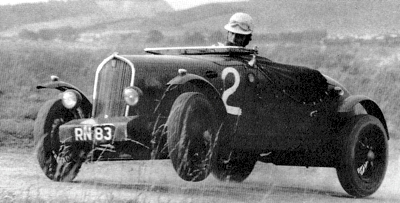 This photo shows how it was possible to extract every last horsepower from the 995cc engine...
This photo shows how it was possible to extract every last horsepower from the 995cc engine... |
Testers' were unanimous over the car's handling and stopping powers, though the headlamps were deemed inadequate for the sports model's performance and the hood was unsatisfactory. The Light Car slated the exhaust note as 'nice, but decidedly naughty'. It was more than a match for either M.G. or Singer, the British cars excelling only in standing-start acceleration as a consequence of their lower gearing. The Fiat's steering was delightfully responsive, but this model was not recommended to drivers with large feet, thanks to the location of the brake pedal in uncomfortable proximity to the steering- column.
Mille Miglia, 1937
Strained relations with Mussolini's Italy restricted sales of touring Fiat's in Britain, but there was no mistaking the enthusiasm with which the Sports Balilla was greeted when it went on show at Olympia in October, 1934. Fiat made a determined attempt to recover their once-strong position in the British market by subjecting the 'Left Hand Drive demonstrator' (BHX 91) to a tough test at Brooklands. Driven by J. Wren and Dudley Froy, it covered a thousand miles over the Mountain Circuit in two days running, encountering, as its makers proudly asserted, 1,700 corners in the process. In spite of poor weather conditions, the mean average speed was 55·11 m.p.h., petrol consumption worked out at 21 m.p.g., and oil was consumed at the rate of a pint every 200 miles.
The English price of £299 was a trifle high at a time when an M.G. Midget could be bought for £222; but this was later reduced to a competitive £238. Cars sold in England were bodied there, and were recognisable by a more pronounced tail fin. The two-seater was the only version of the o.h.v. model regularly available, though the last six chassis imported were fitted with four-seater bodywork, and one of these was shown at Olympia in 1936.
The Italian buyer had, however, a wider choice. In addition to the
spyder normale, there was the spyder corsa, or Coppa d'Oro variant. Contrary to the generally expressed view, this had an identical mechanical specification, the extra m.p.h. being gained by the use of a lighter and starker body shell and cycle-type wings. This was joined in April, 1935, by the Mil1e Miglia type, or Berlinetta Aerodinamica, a fastback coupe with recessed rear number plate and attractive flowing wings.
Fuel tank capacity was increased from ten to fourteen gallons, which made it into a delightful little G.T. with 30-35 m.p.g. on tap. Finally there was an engaging Q-car in the shape of a standard Balilla saloon powered by a 34 b.h.p. version of the o.h.v. Tipo 108S engine. About 1,000 of these were produced. It is difficult to trace the number of overhead-valve cars made in all, as chassis serials ran concurrent with the touring versions, but Unique Cars and Parts USA reseachers doubt if more than 2,000 left the works. Some were also made by Simca and N.S.V., Amedee Gordini winning his spurs on the former, while Brendel achieved quite a few successes on the Heilbronn-built sports cars.
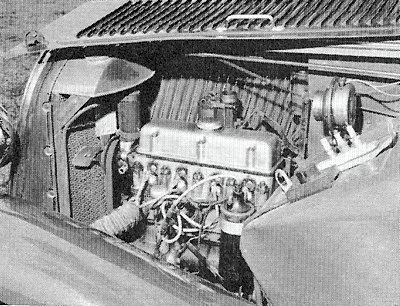 There was plenty of room for the 995cc ohv engine under the bonnet of the 1935 508S, and everything was accessible, even if the mounting of the distributor was not quite water proof...
There was plenty of room for the 995cc ohv engine under the bonnet of the 1935 508S, and everything was accessible, even if the mounting of the distributor was not quite water proof... |
Racing 1935-37
1935 and 1936 were the peak years of the Balilla's competition career, Singer being their strongest opponents. M.G. were out of racing by mid-1935; Adler and Riley concerned themselves mainly with bigger cars, and B.M.W.'s 'works' participation really began with the advent of the Type 328 2-liter in 1936. Surviving Salmsons and Amilcars, though still capable of giving a good account of themselves, were pretty long in the tooth. On occasions, however, they could still turn the tables on the cars from Turin, as happened in the 1935 Alpilles Hill Climb.
The Fiat factory, of course, dropped out of International competition in 1927, never to return, and the great protagonist of the Balilla was a young and still unknown Italian domiciled in France, Amedee Gordini. He had started his career on the pedestrian Tipo 514, and during 1935 he was making himself felt with a car that looked like a standard 508S, but was in fact largely
Le Sorcier's own work. With an alloy block of his own conception, he was extracting 48 b.h.p. from an unblown unit, sufficient to propel a road-equipped car at 90 m.p.h. His score in 1935 was impressive: an outright win in the Bol d'Or 24-Hour Race, and class victories in the Circuit of Orleans, the Grand Prix de Lorraine, and the Grand Prix de la Marne.
Fiat also recorded class wins in the Eifelrennen, the Czechoslovak I,000-Mile Stock Car Race, the Circuit des Vosges (a sort of miniature Alpine Trial) and in numerous hill-climbs, including the Gross-glockner, the Stelvio, the Feldberg, and a couple of forgotten Hungarian contests at Rakosfalva and Mount Gugger. They shone neither at Le Mans nor in the T.T. In the former, the 1,100 c.c. class went to Jacques Savoye's Singer, while in the latter three Fiat's found themselves ranged against three Adlers and four Singers. The German cars were nowhere, but a terrific battle ensued between ffrench-Davis's Balilla and the Singers of Langley, Norman Black, and S. C. H. Davis, with the Fiat generally in the lead. On the eleventh lap 'Sammy' Davis at last built up a good lead for Singer, but the three works cars from Coventry were eliminated spectacularly by steering-arm failure, while ffrench-Davis retired with mechanical trouble towards the end of the race. Sole survivor of the whole class was Dobson's Fiat, dismissed as 'still running at the end'.
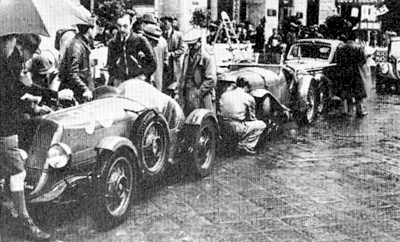 This image is from the 1937 Mille Miglia. Of the two 508S cars shown, the one in the foreground carries lightweight two-seater bodywork, while behind the Maserati is a stock Berlinetta Aerodinamica...
This image is from the 1937 Mille Miglia. Of the two 508S cars shown, the one in the foreground carries lightweight two-seater bodywork, while behind the Maserati is a stock Berlinetta Aerodinamica... |
The four dozen cars sold in England were also making an impression, notably the 'hot' versions conducted by Tuson (DPH 968) and Metcalfe (CMG 99). Tuson's car proved astonishingly reliable, running through three seasons with only minimal replacements. He found that the car's weight distribution was unsatisfactory for trials, but it never failed to win its class in any speed event for which it was entered, while it would turn in 92 m.p.h. on the Outer Circuit at Brooklands. It ran on a compression ratio of 9:1. Metcalfe's car, with 8·2:1 compression, copperised and polished cylinder head, enlarged ports, 36 mm. Stromberg carburetor, Tuson manifold, and a ten-pint sump replacing the standard five-pint type, was good for 42 b.h.p., giving 105 m.p.h. stripped, and 88 m.p.h. in road trim.
When fifteen years old, it could still lap the Goodwood circuit at 68·7 m.p.h. Gordini's Balillas ran as Simcas in 1936, and appeared with narrow bodies and raked radiators reminiscent of the 1933 G. P. Maserati. Gordini himself won his class at Miramas in the Coupe de Provence, despite a mistral, and the cars followed this victory up with a hat-trick in the sports-car class of the Bol d'Or,
Le Sorcier leading Zanardi and Martin home. He also collected a class win in the Belgian 24-Hour Race at Spa. In 1933 there was no Le Mans, though the French ran their Grand Prix as a sports-car event. This policy prevented a German victory, but it also excluded the Simcas from the awards list, since the smallest class embraced every- thing up to 2 liters. Brendel, Soergel, and Zinn took the first three places in the 1,100 c.c. category at the Eifelrennen. The T.T., last of the series to be staged on the Ards Circuit, was again an inauspicious occasion - though Sullivan won his class, he was placed thirteenth out of fifteen finishers.
In Britain, the Balillas were at their zenith. In its report of the Dancer's End Hill Climb that Autumn
Motor Sport referred to the 1,100 c.c. sports class as 'the domain of the FIATs', and in the minor events they were ubiquitous. The Light Car Club's Relay Race at Brooklands saw no fewer than three teams of sports Balillas in circulation - Tuson's, an all- feminine team captained by Miss Chaff, and A. C. Westwood's 'Black Diamonds', regular competitors 9 in rallies. The ladies finished in fourth place at an average speed of 75·12 m.p.h. Stanley Tett won the Blackpool Rally outright in June, and Stothert's Balilla won a first-class award in the M.C.C. Torquay Rally in July. By 1937, however, the cars were past their heyday, even if Vernet and Largeot at last annexed the 1,100 c.c. class at Le Mans. N.S.U.-FIATs were beaten by an M.G. in the Eifelrennen. The T.T., now transferred to Donington Park, was a triumph for Singer, Barnes's and Black's Nines, in fourth and sixth places, being the highest-placed British cars. Gordini was tenth and last after running out of petrol, and Mrs. Dobson's English-entered Balilla was flagged off at the finish.
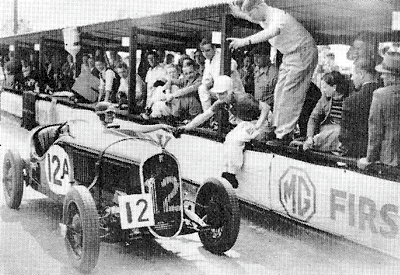 L.C.C Relay Race, Brooklands in 1936. Best of the three Fiat teams entered was Miss D Chaff's all-feminine equipe...
L.C.C Relay Race, Brooklands in 1936. Best of the three Fiat teams entered was Miss D Chaff's all-feminine equipe... |
Swan Song
Further, the new look was moving in on Turin. The last of the long-stroke models, the 72 x 103 mm. six-cylinder 527, had been discontinued at the end of the 1936 season, and already the 518 had been replaced in July, 1935, by the six-cylinder 1500, with coil-spring independent suspension, backbone frame, and aerodynamic pillarless saloon bodywork. It shared the Balilla's cylinder dimensions of 65 x 75 mm. and the valves were overhead. Hot on its heels in 1936 came the immortal
'Topolino' or 500, with 570 c.c. side-valve engine, which sold for £120 in England, and represented an entirely new concept of baby car. The Balilla looked very old-fashioned in this company, and sales slumped to just over 8,000 in 1937.
A replacement was clearly indicated. It came that Autumn in the shape of the original Millecento (Tipo 508C). This was a 508 in name only, for it looked like a scaled-down 1500 or scaled-up 500. The front wheels were independently sprung, and the o.h.v. engine had its bore enlarged to 68 mm. to bring it close up to the 1,100 c.c. limit. The cylinder head was now of aluminum alloy, and it was a remarkable little performer, being very nearly as fast as the 508S two-seaters on only 32 b.h.p. Though the 508C and its derivatives are often erroneously called Balillas, they are a breed in their own right.
SPECIFICATIONS
FIAT Tipo 508 and 508S (Side Valve)
- Engine: 4 cylinders, monobloc, side valves, detachable cast iron
head, 4-point suspension, 3-bearing crankshaft. Bore 65 mm.
Stroke 75 mm. Capacity 995 c.c. Nelson Bohnalite alloy pistons.
Full pressure lubrication by submerged gear type pump.
Thermo-syphon cooling with fan assistance.
Fuel feed: 3-speed 508, Gravity feed by 6-gallon dash tank to
Solex 26FH or Zenith 26VF downdraught carburetor. 7-gallon
tank on 4-speed 508 models. 508S has mechanical pump feed
from 12-gallon rear tank to Zenith 30VEIZ downdraught carburetor. Compression ratios: Optional 5·8 or 6'3:1 in 1932. 6,3:1
standard on later 3-speed 508, January 1933-1934. 6,6:1 on
4-speed cars. 7: I on 508S.
Output: (3-speed 508) 22 b.h.p. at 3,400 r.p.m. (4-speed 24
b.h.p. at 3,600 r.p.m.: 508S, 30 b.h.p. at 4,000 r.p.m.
- Gearbox: (3-speed 508) 3 speeds and reverse, central change.
Ratios (saloons) 5'2, 9'5, and 14·9 to I. Top gear ratio 4'89:1
on roadsters, 5'375:1 on light delivery vans. 508S has 4,3:1 top
gear.
(4-speed gearbox) 4 speeds and reverse, central change, synchro-
mesh on top and 3rd gears. Ratios (saloon and tourer), 5·1,(
7'5, 11·4 and 18·9 to I. Top gear ratio 4,875:1 on roadster
5·375: I on light delivery vans. Free wheel optional extra on
'versions except 508S.
Clutch: Single dry plate.
- Transmission: Open propeller shaft, universally-jointed
each end. Spiral bevel final drive.
Ignition, Lighting and Starting: Marelli 12-volt coil and
distributor, with belt-driven dynamo. 12-volt lighting and
starting, five-lamp lighting set (3-lamp on standard 3-speed
models of Tipo 508).
Chassis: Cruciform-braced with deep channel section side
members.
- Brakes: Foot, hydraulic internal-expanding on four wheels.
Handbrake, transmission type on drum behind gearbox.
- Steering: Worm and wheel.
- Suspension: Semi-elliptic front and rear. Hydraulic shock
absorbers on 508, friction type on 508S.
Wheels: FIAT bolt-on disc or wire detachable (wire only on
508S).
Tires: Pirelli, 4'00x 17.
- Dimensions: Wheelbase (3-speed 508 and 508S) 7 ft. 4i in.
(4-speed 508) 7 ft. 6i in. Track 3 ft. 10;} in.
- Weight: Standard two-seater, 3-speed, 13 cwt. Standard
2-door saloon, 3-speed 13':' cwt. Standard 4-door saloon,
4-speed, 15i cwt.
- Performance: (3-speed Tipo 508) maximum speeds, on top
gear 58 m.p.h.; on second gear 28 m.p.h.; on 1st gear 14 m.p.h.
(4-speed Tipo 508) maximum speeds, on top gear 58 m.p.h.; on
3rd gear, 50 m.p.h.; on 2nd gear, 34 m.p.h.; on I st gear, 18 m.p.h.
(3-speed Tipo 508S) maximum speeds, on top gear 68 m.p.h.;
on 2nd gear, 43 m.p.h.; on 1st gear 23 m.p.h.
Fuel consumption, all types, 35 m.p.g.
FIAT TIPO 508S (O.H.V.) 1934 to 1937
- Engine: 4 cylinders, monobloc, push rod-operated overhead. Detachable cast iron head, 3-bearing crankshaft. Stroke 75 mm. Capacity 995 c.c.
Nelson Bohnalite alloy pistons. Full pressure lubrication by
submerged gear type pump. Thermo-syphon cooling with fan assistance. Mechanical pump feed from 10-gallon rear tank
to Zenith 30VEIZ
or 30VIM downdraught carburetor. Compression ratio 7·1: I. Output 36 b.h.p. at 4,400 r.p.m.
- Gearbox: 4 speeds and reverse, central change. Synchromesh
Ratios, 4·3, 5·7, 8·6 and 14·4 to 1.
- Clutch: single dry plate, short-stroke
- Transmission: Open propel!er shaft, universally jointed front
and rear. Spiral bevel final drive.
- Ignition, Lighting and Starting: Marelli 12-volt coil, with
reputation now hangs mainly on its 'vintage' driving belt-driven dynamo. 12-volt lighting and starting, 51amp lighting.
- Brakes: Foot, hydraulic internal expanding on four wheels.
- Steering gear: Worm and wheel.
objectives other than assaults on the perpendicular
- Wheels: FIAT bolt-on wire detachable.
- Tires: Pirelli, 4·00x 17.
- Dimensions: Wheelbase 7 ft. 6i in. Track 3 ft. 10 in.
- Performance: Speeds on gears: Top, 70 m.p.h., 3rd 60 rn.p.h., Acceleration through gears, 0-50 m.p.h., 186 secs., 0-60 m.p.h Fuel consumption approx. 30-35 m.p.g.
